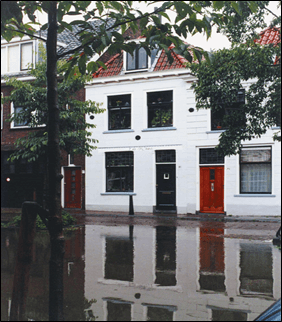
Rietveld - Walkingroute Waterways
Rietveld the most low-lying part of the historic city centre of Delft
RIETVELD - THE MOST LOW-LYING PART OF THE HISTORIC CITY CENTRE OF DELFT
The most low-lying part of the historic city centre of Delft
In Rietveld (and also Vlamingstraat) the difference between street level and the water level is only 25 cm, whereas in Oude Delft (at the start of this walk) it is around 150 to 200 cm. The water level is exactly the same, namely Delflands Level = NAP - 0.42 m (Normaal Amsterdams Peil/Amsterdam Ordnance Datum). The difference lies in the street level.
The expansion of the city of Delft through the centuries too…
RIETVELD - THE MOST LOW-LYING PART OF THE HISTORIC CITY CENTRE OF DELFT
The most low-lying part of the historic city centre of Delft
In Rietveld (and also Vlamingstraat) the difference between street level and the water level is only 25 cm, whereas in Oude Delft (at the start of this walk) it is around 150 to 200 cm. The water level is exactly the same, namely Delflands Level = NAP - 0.42 m (Normaal Amsterdams Peil/Amsterdam Ordnance Datum). The difference lies in the street level.
The expansion of the city of Delft through the centuries took place on areas of peat soil. In recent decades this part of Delft in particular has suffered subsidence as a result of natural soil subsidence, groundwater extraction and intensive construction. These processes also led to a lowering of the water level and groundwater level. The peat that was thus exposed oxidised and reduced in volume.
Subsidence in the Netherlands greater than expected – research at TU Delft
The new Dutch Land Subsidence Map has enabled researchers to distinguish for the first time between the deep causes of subsidence, such as gas extraction, and the effects in the uppermost few metres. Until now, it was not possible to directly measure this top layer. It turns out that this ‘shallow’ subsidence is even greater in some places in the Netherlands than the more familiar, deep causes. In the peat and clay areas in the west of the country especially, this subsidence is now clearly measurable. Its effect over the last summer is also noticeable, with dozens of houses showing cracks and subsidence caused by the dry weather. Climate change appears to play a major role in this accelerated subsidence. The relatively warm summers cause more dehydration of the peat soils, speeding up subsidence. This process is irreversible: the peat oxidises, which also means that more CO2 is released into the atmosphere. More on this research.
Sliding gate mechanism as protection
The mechanism at the end of Rietveld into the Schie was installed in 2000 as an emergency measure to protect Rietveld. There is a similar mechanism in Vlamingstraat. In 2008 this mechanism was adapted and both are now part of the total defence system for this vulnerable part of the Delft city centre.
The mechanism comprises a fixed vertical sheet pile (film Water in Zicht 1, 17:31) with a gap in the middle. This gap can be closed with a hydraulic-power-operated vertical sliding gate. It works in the same way as the tilting barriers.